Hannibal, MO: Meet Springfield, USA
Things to Note
In "The Simpsons Tall Tales," Simpsons characters satirize and play on many Twain references, both famous and subtle. The episode is, at best, only loosely based on The Adventures of Tom Sawyer. In general, it plays on the kind of language Twain employed and the well-known characters that he used, like Tom, Huck, Becky, and Judge Thatcher.
Twain's Tall Tale
Perhaps the most interesting aspect of the entire Simpsons take on Twain comes during the intro to the actual sketch. The Simpsons characters listen to an old hobo tell American Tall Tales. After telling the Paul Bunyan and Johnny Appleseed tales, the hobo sees the Mississippi River, and says, "Reminds me of a tall tale about two scallywags rafting down the big muddy--Tom Sawyer and Huck Finn." Lisa protests, saying "That's not a tall tale; it's a book, by Mark Twain." The hobo responds: "Look, let's just do this thing."
On one level, this is just another silly Simpsons joke--the hobo doesn't know that Tom and Huck were the product of an author. On quite another level, though, it reveals how deeply Tom, Huck, and Mark Twain have become engrained in the American cultural consciousness, as icons of American literary history. The hobo can't distinguish Twain's stories from some incredibly famous tall tales, and by inclusion in the "Tall Tales" episode of the Simpsons, neither can the writers. Tom and Huck have become American icons in the same vein as Paul Bunyan and Johnny Appleseed..
-
to view a clip of the hobo discussing the "tall tale" of Tom and Huck, click here.
Fitting characters
Part of the reason the Simpsons' writers chose to do a story based on Tom and Huck must have had something to do with how well Bart's character matched with Tom's. Tom Sawyer was the bad boy of the 1840s--constantly getting into mischief, driving his parental figures wild, and possessing a real penchant for productions and performance. Much of the same can be said of the bad boy of the early 1990s--Bart Simpson. Bart slides easily into this role, as an icon of American boyhood from a different era. He also constantly is showing off, play-acting, and getting into trouble, but like Tom Sawyer, deep down he has a heart of gold. What kinds of similarities do the two possess, specifically?
Nelson as Huck Finn is a more interesting comparison. On the show, Nelson plays a big bully, and is nowhere near as friendly and human as Huck Finn. However, there are certain similarities--they both fit a certain "poor-white" stereotype, Nelson's and Huck's parents are both either dead or absent for most of their lives, and Nelson and Huck both manage to have interesting and dangerous adventures. How well do you think Nelson fits the Huck Finn stereotype?
The 'whitewashing' scene
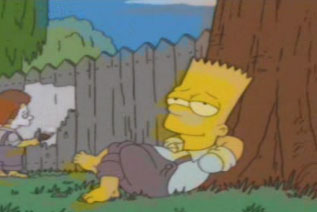 One
of the best-known and best-loved moments in The Adventures of Tom Sawyer
is the whitewashing scene, where the wily Tom convinces half the
neighborhood children to not only do his chore of painting for him, but to
actually pay him for the privilege. By making the odious task seem
desirable to the neighborhood kids, Tom shows his smarts, gets out of
his chores, and becomes richer in the process.
One
of the best-known and best-loved moments in The Adventures of Tom Sawyer
is the whitewashing scene, where the wily Tom convinces half the
neighborhood children to not only do his chore of painting for him, but to
actually pay him for the privilege. By making the odious task seem
desirable to the neighborhood kids, Tom shows his smarts, gets out of
his chores, and becomes richer in the process.
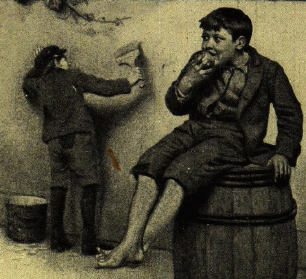
"The Simpsons'" take on the whitewashing scene is quite different, of course. Now Tom and Huck are whitewashing the fence together (Huck: "Whitewashing sucks, Tom. It powerful sucks"). And this time, instead of Tom's finagling and finesse, Huck, as Nelson the bully, simply slams the neighborhood childrens' heads into the paint, and then yells at them to "Get to work!"
-
to view a clip of the Simpsons whitewashing scene, click here.
-
to read the scene in The Adventures of Tom Sawyer, click here.
The Becky/Tom Scene

Another famous scene from Tom Sawyer is when Tom first falls in love with Becky Thatcher, and shows off in front of her house for several hours, in hopes that she'll catch a glimpse and reciprocate his affections. In "The Simpsons," the episode is replayed, only now it is with Huck instead of Tom. This makes sense on a certain technical level, because Becky is played by Lisa, Bart (Tom's) sister--it wouldn't do to have the Simpsons siblings fall in love.
After showing off on top of the fence, Becky tells him to be careful, lest he break his neck. Huck replies: "I'll just get a new neck... off'n a cat," a reference to the dead cat which Huck uses in superstitious rites in Tom Sawyer. When Huck falls off the fence, Becky comes to his rescue, and they both fall in love. Caught holding hands by Judge Thatcher (a hilariously miscast Homer Simpson), they are forced to have a shotgun wedding.
The Rafting Scene
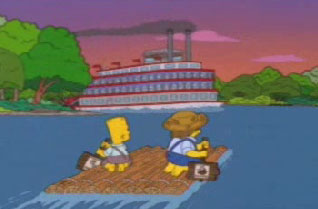
Perhaps the rafting trip is the most striking aspect of "The Simpsons" episode's take on Huck and Tom's adventures. In Adventures of Huckleberry Finn, the river and the raft are the main literal and metaphorical vehicles of the text, the engine through which the runaway slave Jim both escapes slavery and finds his humanity. The journey down the river in Huckleberry Finn is in general a more serious and artistic enterprise than much of the rest of Twain's fiction.
In "The Simpsons" episode, Jim is completely absent. While this is not particularly egregious in a show that is meant to be funny, it is interesting that the writers would choose to eliminate the most crucial character, besides Huck, in all of Huckleberry Finn, and reduce the raft to a mere set piece. The raft is still used to aid runaways, but now their crimes are "Marriage-dodging" and "Moonshining" (the exposing of Bart's bare bottom, not the making of bathtub liquor) rather than escaping slavery or aiding a runaway slave.
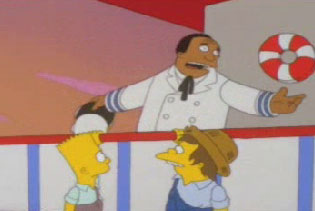 There
is, it turns out, a steamboat on this rafting trip as well, but instead of
being an old wreck, dangled precariously on rocks, it is a grand, decadent
steamboat, with gambling tables and a bar. The use of the steamboat
recalls Twain's own adventures and familiar relationship with steamboating,
as he was a steamboat pilot for 4 years. Interestingly, too, the first
character Tom and Huck meet on the steamboat is Doctor Hibbert, dressed as
the riverboat captain, and singing "Ol' Man River" from the musical
"Showboat." Since Dr. Hibbert is black, and this song is sung by a
black character, it is interesting that the creators chose to confront race
in this way rather than by including Jim.
There
is, it turns out, a steamboat on this rafting trip as well, but instead of
being an old wreck, dangled precariously on rocks, it is a grand, decadent
steamboat, with gambling tables and a bar. The use of the steamboat
recalls Twain's own adventures and familiar relationship with steamboating,
as he was a steamboat pilot for 4 years. Interestingly, too, the first
character Tom and Huck meet on the steamboat is Doctor Hibbert, dressed as
the riverboat captain, and singing "Ol' Man River" from the musical
"Showboat." Since Dr. Hibbert is black, and this song is sung by a
black character, it is interesting that the creators chose to confront race
in this way rather than by including Jim.
-
to learn more about and listen to the complete "Ol' Man River," click here.
"Lighting Out"
In the episode, Tom and Huck do something they never did either The Adventures of Tom Sawyer or Adventures of Huckleberry Finn--they get aboard a working steamboat. Unfortunately, their adventure is short lived, as they are quickly kicked off for causing disturbances. On the way off the boat, the bartender Moe tells the boys to "Light out, and stay lit out!" This, of course, is a cute reference to a phrase Huck uses occasionally, but most notably in the final line of Huckleberry Finn: "But I reckon I got to light out for the Territory ahead of the rest, because Aunt Sally she's going to adopt me and sivilize me, and I can't stand it. I been there before."
-
to see Moe kick the boys off the steamboat, click here.
Visiting their own funeral
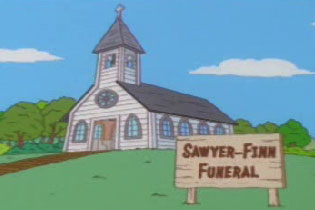 In
The Adventures of Tom Sawyer, Huck, Tom and their friend Joe Harper
spend a few nights on Jackson's Island, a secluded spot a few miles from St.
Petersburg. Since the boys didn't give notice of where they were
going, their families panicked, convinced themselves the boys had drowned,
and held a funeral for them the following Sunday. Tom, overhearing the
plan for the funeral, convinces the boys to wait a few days and then march
in on their own funerals. Twain describes the scene in chapter 17 of
Tom Sawyer:
In
The Adventures of Tom Sawyer, Huck, Tom and their friend Joe Harper
spend a few nights on Jackson's Island, a secluded spot a few miles from St.
Petersburg. Since the boys didn't give notice of where they were
going, their families panicked, convinced themselves the boys had drowned,
and held a funeral for them the following Sunday. Tom, overhearing the
plan for the funeral, convinces the boys to wait a few days and then march
in on their own funerals. Twain describes the scene in chapter 17 of
Tom Sawyer:
There was a rustle in the gallery, which nobody noticed; a moment later the church door creaked; the minister raised his streaming eyes above his handkerchief, and stood transfixed! First one and then another pair of eyes followed the minister's, and then almost with one impulse the congregation rose and stared while the three dead boys came marching up the aisle, Tom in the lead, Joe next, and Huck, a ruin of drooping rags, sneaking sheepishly in the rear! They had been hid in the unused gallery listening to their own funeral sermon!
This Simpsons episode plays on the familiar story, but with a very twisted result. The boys spend most of the episode running from Judge Thatcher and his cronies, who are in hot pursuit. They are eventually apprehended at the end of the episode. The next cut is to the church, with a sign outside reading "Sawyer-Finn Funeral." Inside the church, the pastor is saying a few remarks about the boys, and there are two matching small coffins in front of him. The next scene, however, is a surprise--the boys are both on the rafters above, watching their own funerals and listening to the pastor give their funeral sermon, just like in the book:
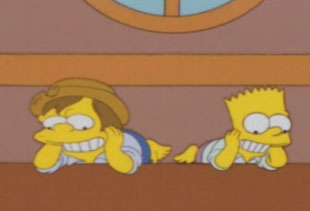
However, the pastor immediately after intones, "Now for the traditional lowering of the bodies into the caskets." It turns out that the boys were caught after all, in a funny, if somewhat macabre, send-up of Twain. This seems a parody of both the scene in Tom Sawyer, and of Twain's tendency to miraculously get Tom Sawyer out of whatever scrape he's in:
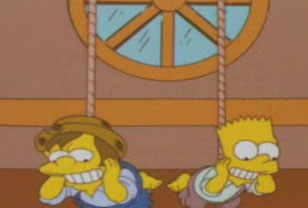
-
to read Twain's full account of Tom visiting his own funeral, click here.
-
to view the funeral of Huck and Tom, as portrayed by "The Simpsons," click here.